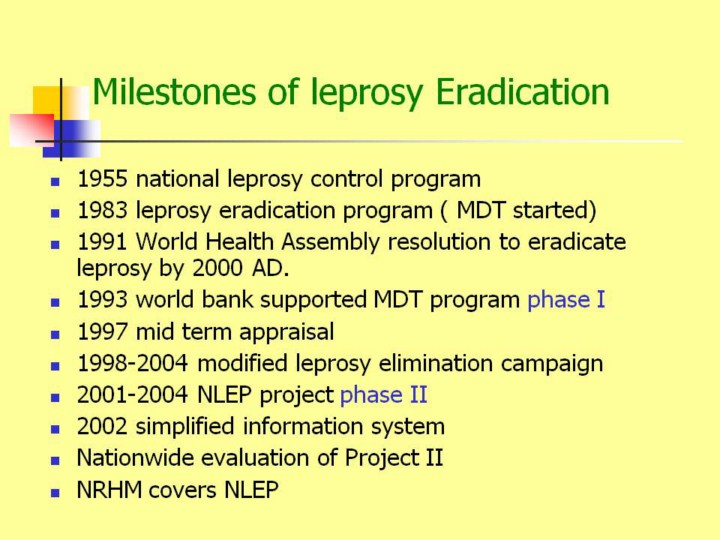| front |1 |2 |3 |4 |5 |6 |7 |8 |9 |10 |11 |12 |13 |14 |15 |16 |17 |18 |19 |20 |21 |22 |23 |24 |review |
 |
The 1st Phase of the World Bank supported National Leprosy Elimination Project started from 1993-94 and completed on 31.3.2000. This Project involved a cost of Rs. 550 crores of which World Bank loan was Rs. 292 crores. During this phase, the prevalence rate reduced from 24/10,000 population in 1992 before starting 1st Phase project to 3.7/10,000 by March 2001. The 2nd Phase of World Bank Project on NLEP started for a period of 3 years from 2001-02. The project involve a cost of Rs. 249.8 crore including World Bank loan of Rs. 166.35 Crore and WHO to provide MDT drugs free of cost worth Rs. 48.00 crore. The project successfully ended on 31st Dec. 2004 The National Health Policy, Govt. of India sets the goal of elimination of leprosy i.e. to reduce the no. of cases to < 1/10,000 population by the year 2005. The National Leprosy Eradication Programme took up the challenge with the active support of the State/ UT Governments and dedicated partners in the World Health Organisation, the International Federation of Anti Leprosy Associations (ILEP), the Sasakawa Memorial Health Foundation & the Nippon Foundation, NOVARTIES, DANLEP (1986-2003) and the World Bank (1993-2004). As a result of the hard work and meticulously planned and executed activities, the country achieved the goal of elimination of leprosy as a public health problem, defined as less than 1 case per 10,000 population, at the National Level in the month of December, 2005. As on 31st December 2005, Prevalence Rate recorded in the country was 0.95/10,000 population. |